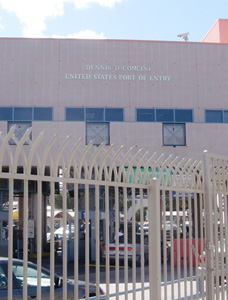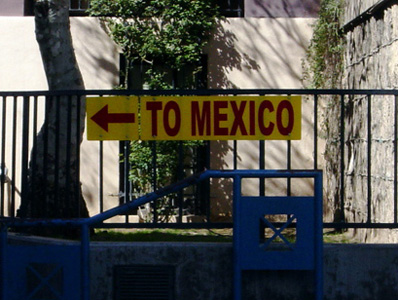 |
|
|
INS & the Border Patrol
On our trip down to Nogales and the border region between the US and Mexico, there were a number of things that struck me. One thing that got my attention immediately was the border guard that was assigned to greet our class and give us the tour of the Dennis D. Concini United States Port of Entry. It seemed right at the start that there was something calculated about the choice of guides. He was very careful about how he answered our questions, or if they should be answered at all. Sometimes, the questions he didn’t answer were statistical ones, so I didn’t necessarily count those because I didn’t expect him to have all the numbers memorised. It was as if INS and the Border Patrol had the tour plotted out to keep it within certain boundaries, and when questions were outside the box, they were gingerly and generically answered or deflected. It is difficult to define what specifically made the whole tour seem so unnaturally forced, but the feeling was not only perceived by me. Something tangible was in the air and most of us felt it, even if we couldn’t put our finger on why. I would say that it is possible that a portion of that reaction was due to the border patrol tour being the first thing to follow our stop at Borderlinks in Tucson, where the obvious distaste for INS and the Border Patrol was not hidden or masked. One of the readings given out by Borderlinks called, “Rape as a weapon of War: Advancing Human Rights for Women at the US-Mexico Border” by Sylvanna Falcon puts a sharp light on the INS and Border Patrol officers as being part of a war on the border. If true, this could in fact explain some of the secrecy and strange behaviour on the tour we were on at the port of entry. Falcon states “…that rape is one outcome of militarization along the U.S. – Mexico border.” And I think this is a real concern. The examples sited in the article of officers raping Mexican women along the border, and inside the US under the pretence of “helping them” with deportation trials, or in exchange for not reporting or deporting them are disturbing, and the sentences and time served in each case is almost a joke. This one factor alone could result in an apprehension by officials to give out much detail on border procedures during tours. As much as I don’t want to think that members of my own government could be capable of the deliberate supporting of rape, I can not say that I don’t believe it possible. It is a sickening thought, and should be investigated by a third party in my opinion.
I also had to react to another article from the Borderlinks packet called “Arizona Ranchers Hunt Mexicans” by Jose Palafox. When you are on the Mexican side of the border as we were, you see a lot of people that have placed their last hopes on coming to this horrid place in an attempt to get across the border and find a better life if not for themselves, then for the families they leave behind and intend to send money to. When your life and the well being of your family gets so desperate that you are willing to risk your life to cross a dangerous border and find work in a place where you may not be overly welcome or treated overly fairly, you don’t need any more obstacles placed in front of you than you already know to expect. Yet here in this article we read about white supremacists and anti-immigration oriented civilians providing another danger to overcome. These are vigilante style extremists getting off on the power of a citizen’s arrest. “Racist xenophobes” (p107) as the article calls them. They set up under the guise of “protecting private property” and other such weak excuses. Ranchers have actually advertised for people to come out and watch their property from their RV’s saying “Help an American rancher keep his land protected while enjoying the great southwestern desert at the same time.” (p108) Truly these immigrants have earned some respect if they have managed to get across the border alive and elude the border patrol as they seek a better opportunity. For them to make it through all that, then come upon one of these guys and have a gun shoved in their face by men not wearing uniforms, and to possibly be hit or kicked as they are herded up must be traumatising. You wouldn’t know what they are going to do next, and I would imagine at first it would almost be a relief to see the INS vehicle arrive to pick you up. Prior to that point you wouldn’t know if you were headed to your own death, or slavery or what ever else you might imagine.
My personal reaction to the day at the border along with the readings provided by Borderlinks was to be enlightened to the power of the human spirit. Sometimes I feel that so many people are willing to just sit back and let what happens happen. But when you go to this border region and you see this many people in various stages of attempt or success at improving their lives, it is moving. For me, it didn’t cause a sense of sorrow, or of feeling lucky to be born American so much as it moved me to see that people will not give up. I saw a population that was saying “Hey, you can’t keep us down forever” and was doing something about it. Maybe they don’t have the time or organisation to put together a purposeful political movement, but their sheer numbers and intentions are doing a lot of talking for them. The numbers and tragedies have grown to a magnitude too extensive to be ignored. Because of this, they now have people like the Borderlinks folks (and others) who do have the time to organise and make political statements, and who are trying to look out for them and draw attention to their plight. These immigrants have desire, they have drive in the face of extreme adversity. Having fight when you could just lay down and die is part of the beauty of humanity. It makes me proud to be a human being, just like them. I look forward to the day when this inhumane treatment is just a black mark in the history books and not a day to day reality.
|
|
| Return to Migration & Culture Home Page | Send me an e-mail |

